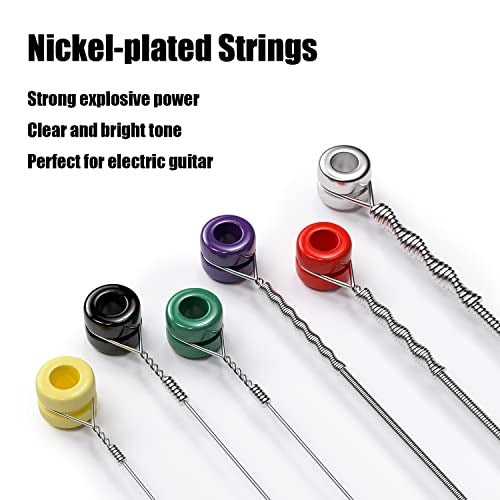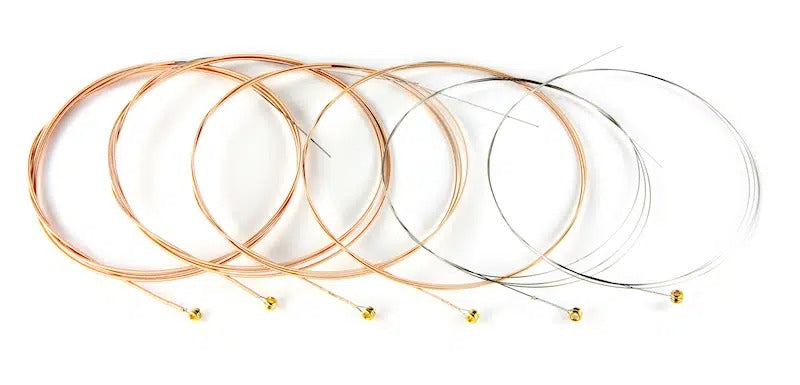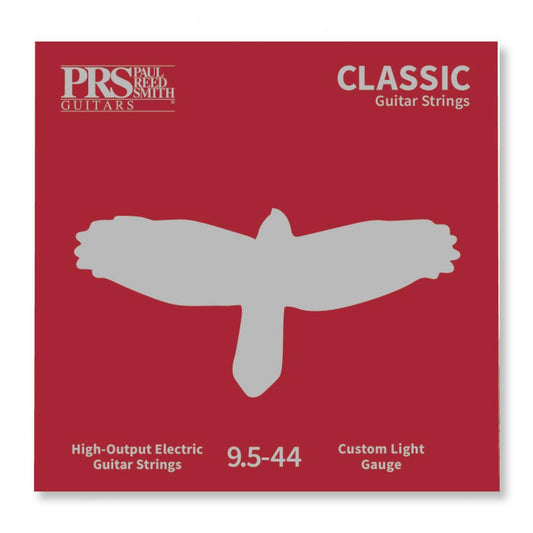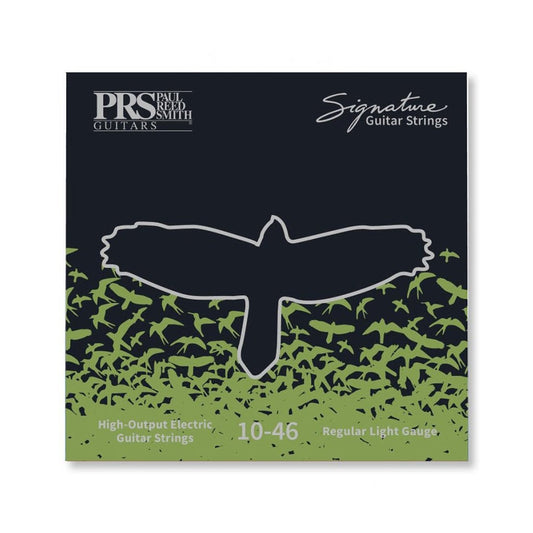Dây Đàn Guitar
Dây Đàn Guitar
Những điều bạn cần biết về dây đàn guitar.
Là bộ phận chịu lực từ các ngón tay, đồng thời cũng thường xuyên tiếp xúc với mồ hôi và môi trường, vì thế sau một thời gian sử dụng, dây đàn guitar nhanh chóng bị rão và hao mòn. Lúc này bạn cần thay mới dây để đảm bảo chất lượng âm thanh của cây đàn.
Như chúng ta đã biết, dây đàn guitar ảnh hưởng trực tiếp đến việc quyết định âm thanh của cây đàn có hay, mượt mà hay không. Chính vì lý do đó nên việc thay mới dây là cần thiết. Dây đàn guitar có rất nhiều loại, có nhiều yếu tố bạn cần xem xét trước khi quyết định lựa chọn loại nào như lớp phủ, loại dây quấn và vật liệu…
Dây đàn guitar được làm từ gì?
Khi tìm dây đàn guitar mới, điều đầu tiên và quan trọng nhất cần xem xét là chất liệu làm ra chúng. Trên thực tế, dây đàn guitar không được làm từ chất liệu phù hợp có thể không tương thích với cây đàn của bạn! Vật liệu dây có thể được chia thành ba loại lớn tùy thuộc vào việc chúng dành cho guitar điện, acoustic hay classic. Ngoài ra, các vật liệu khác nhau có thể ảnh hưởng đến âm thanh và cảm giác của dây đàn, ngay cả khi chúng được sản xuất cho cùng một loại đàn ghita.
Vật Liệu Dây Đàn Guitar Điện
Dây đàn guitar điện phải được làm bằng kim loại để bộ thu của đàn guitar truyền rung động thành tín hiệu điện.
Niken

Nói chung, dây đàn guitar điện được làm bằng thép, với ba dây thấp nhất được mạ niken. Cho đến nay, dây đàn guitar điện mạ niken là phổ biến nhất và chúng mang lại sự cân bằng tốt giữa độ ấm và độ sáng, đồng thời có thể giúp cây đàn nổi bật hơn so với các nhạc cụ khác.
Đối với những người tìm kiếm âm thanh ấm hơn, chẳng hạn như nghệ sĩ guitar jazz, dây niken nguyên chất (không mạ) có thể là một lựa chọn thích hợp. Dây niken nguyên chất mang đến âm thanh ấm áp, tròn trịa với âm thanh cổ điển mà không có quá nhiều âm sắc “chói”.
Thép
Nếu bạn đang tìm kiếm một giai điệu mạnh mẽ hơn, dây thép nguyên chất là một sự lựa chọn tốt. Thép nguyên chất mang lại âm thanh rất tươi sáng với nhiều tần số cao và bền vững. Ngoài ra, dây thép nguyên chất có khả năng chống ăn mòn cao nhất và rất bền. Những người chơi nhạc rock và metal thường sử dụng loại dây này.
Coban, titan và đồng
Một số dây đàn guitar điện được làm từ các kim loại khác, chẳng hạn như coban, titan và đồng, nhưng những loại này khó tìm, đắt tiền và ít người chơi sử dụng hơn.
Vật Liệu Dây Đàn Guitar Acoustic

Dây acoustic cũng có lõi thép nhưng được mạ bằng các kim loại khác nhau. Ba lựa chọn phổ biến nhất cho guitar acoustic là đồng thau brasss (thường được gọi là hợp kim đồng - bronze hoặc bronze 80/20), đồng phốt-pho (phosphor bronze) và dây hỗn hợp.
Bronze 80/20 được làm từ 80% đồng và 20% kẽm. Đây có lẽ là tùy chọn phổ biến nhất và chúng mang lại âm thanh sáng, rõ ràng. Tuy nhiên, loại kim loại này bị ăn mòn nhanh chóng và âm thanh có thể giảm đi chỉ sau vài giờ chơi.
Dây đồng phốt pho (phosphor bronze) nhằm mục đích tăng tuổi thọ của dây bằng đồng thau bằng cách thêm thành phần phốt pho để ngăn quá trình oxy hóa dây. Điều này mang lại cho dây sự ổn định và mạnh mẽ hơn với cái giá là âm sắc trầm hơn một chút và độ sáng kém hơn. Nếu bạn thường xuyên đi biểu diễn thì sự lựa chọn này là rất phù hợp.
Loại cuối cùng của dây đàn guitar acoustic được gọi là dây hỗn hợp (compound strings) hoặc dây lụa và thép . Đây là những dây nylon hoặc lụa quấn kim loại. Lõi nylon hoặc lụa mềm hơn dẫn đến độ căng của dây thấp hơn và âm thanh nhẹ nhàng.
Dây nylon tráng/phủ đôi khi cũng được sử dụng làm dây bass trên đàn guitar classic.
Vật Liệu Dây Guitar Classic (cổ điển - nylon)

Dây nylon thường được tìm thấy nhiều nhất trên các guitar cổ điển vì giai điệu êm dịu và phức hợp của chúng. Có nhiều loại dây nylon khác nhau, chẳng hạn như dây nylon chỉnh lưu hoặc đen, nhưng dây nylon trắng và dây nylon mạ là phổ biến nhất. Dây nylon trơn được sử dụng cho ba dây trên cùng, trong khi dây nylon mạ thường dùng cho dây dưới.
Không giống như dây acoustic và dây điện, dây nylon không có đầu hình bóng và chúng phải được buộc xung quanh ngựa đàn của cây đàn guitar.
Trước dây nylon, các nghệ sĩ guitar cổ điển thường sử dụng dây “catgut” làm từ ruột cừu hoặc các loại gia súc khác. Loại dây làm từ chất liệu này rất dễ đứt và không chắc chắn.
Kích Thước Dây Đàn Guitar
Một trong những đặc điểm rõ ràng nhất của dây đàn guitar là độ lớn của chúng. Dây đàn guitar acoustic và điện được phân biệt theo kích thước dây trong khi dây cổ điển được phân biệt dựa trên độ căng.
Một trong những yếu tố quan trọng nhất cần xem xét khi mua dây đàn guitar là kích thước đề cập đến độ dày của dây. Dây mỏng (light) nhất thì nhẹ hơn và dây dày (heavy) nhất thì nặng. Đây là tiêu chuẩn chung về kích thước dây nhưng thực tế sẽ khác nhau tùy thuộc vào thương hiệu và quan trọng nhất là dây dành cho nhạc cụ điện hay nhạc cụ acoustic (dây đàn guitar điện nhỏ hơn dây đàn acoustic).
May mắn thay, các bộ dây cũng sẽ bao gồm thông tin số thực tế về độ lớn của dây được đo bằng 1/1000 inch. Ví dụ: hãy xem xét một thương hiệu và các thông số đính kèm của chúng:
Extra Light [điện] – (.009/.011/.016/.024/.032/.042)
Các con số đề cập đến đường kính của dây, tính bằng mm, đi từ dây E cao đến dây E thấp.
Vì vậy, dây E cao của bộ phụ nhẹ có đường kính 0,23 mm, trong khi dây E cao của bộ nặng có đường kính 0,36 mm. Nghe có vẻ không nhiều, nhưng đó là một sự khác biệt thực sự lớn và sẽ có tác động rõ rệt đến cảm giác và âm thanh!
Dây có độ nặng nhẹ, cái nào tốt hơn?
Cuộc tranh luận giữa dây nhẹ và dây nặng đã diễn ra trong nhiều năm mà không có sự đồng thuận rõ ràng nào. Câu trả lời từ các chuyên gia là nó phục thuộc vào sở thích cá nhân và loại nhạc bạn muốn chơi. Dây nhẹ hơn rất tốt cho việc uốn dây (bending), dễ chơi và âm sắc tươi sáng. Tuy nhiên, dây khổ nhẹ có thể dễ bị đứt hơn và chúng có thể không giữ được độ bền khi sử dụng nhiều. Mặt khác, dây kim loại được các nghệ sĩ guitar điện và những người chơi theo phong cách rock ưa chuộng. Những dây này dày hơn, vì vậy nếu bạn muốn âm lượng lớn hơn, ít đứt dây hơn, âm trầm lớn và bền hơn, thì dây nặng hơn sẽ cung cấp tất cả những điều đó. Tuy nhiên, chúng cần nhiều áp lực hơn để ấn xuống nên khó chơi hơn và có thể gây chuột rút hoặc đau tay cho những người chưa quen.
Đối với dây cổ điển, thay vì được phân loại theo tiêu chí “dày”, “mỏng” thì chúng lại được phân loại theo độ căng thấp, trung bình hoặc cao. Tiêu chí này chỉ trọng lượng của lực căng đặt lên cổ đàn guitar. Dây có độ căng cao cho âm thanh to hơn, sáng hơn nhưng khó chơi hơn. Các dây có độ căng thấp có xu hướng có âm thanh cân bằng hơn, dễ chơi hơn nhưng cũng sẽ không phát ra âm thanh tốt.
Thuật ngữ độ căng “cao” và “thấp” không được chuẩn hóa và khác nhau giữa các thương hiệu, vì vậy hãy đảm bảo kiểm tra trang web của nhà sản xuất để xem trọng lượng độ căng chính xác cũng như kích thước dây.
Bạn cần chú ý với các dây có độ căng cao hoặc dây dày sẽ tạo thêm lực căng lên cần đàn. Điều này có thể gây cong vênh hoặc hư hỏng nếu đàn guitar không quen với áp suất cao hơn đó, đặc biệt nếu đàn cổ điển hoặc đã lâu không được sử dụng.
Cách Quấn Lõi Dây Guitar
Cách dây được quấn quanh lõi rắn sẽ thay đổi đáng kể cảm giác và âm thanh của dây đàn. Ngay cả những người chơi mới bắt đầu cũng có thể cảm nhận và nghe thấy sự khác biệt ngay lập tức.
Có ba cách chính được sử dụng để quấn dây: quấn tròn, quấn phẳng và nửa vòng.
Quấn tròn (roundwound): Dây quấn tròn cho đến nay là lựa chọn được sử dụng rộng rãi nhất, linh hoạt, sẵn có và rẻ nhất cho dây đàn guitar. Những dây này sử dụng dây tròn để bọc lõi bên trong và điều đó tạo cho dây một bề mặt có kết cấu giúp người chơi dễ dàng bấm. Do đó, dây quấn tròn thường được ưu tiên cho các phong cách đòi hỏi phải gẩy ngón nhiều, chẳng hạn như blues hoặc rock. So với dây quấn phẳng, dây quấn tròn có âm thanh sáng hơn, bền hơn và sự hiện diện của hài âm cao hơn. Tuy nhiên, do kết cấu dây cuốn tròn thô nên sẽ có nhiều tiếng ồn, đây có thể được cho là điểm mạnh đối với phong cách âm nhạc mạnh mẽ. Còn ngược lại, nó sẽ nhanh khiến dây dần bị mòn.
Dây cuốn phẳng (flatwound): Dây cuốn phẳng thường được các nghệ sĩ guitar chơi nhạc jazz và những người thích âm thanh êm dịu, tròn trịa và ấm áp lựa chọn. Chúng cũng là loại dây đàn guitar bass phổ biến nhất! Vì dây quấn phẳng quấn một sợi dây phẳng xung quanh lõi dây nên chúng ta có cảm giác mượt mà hơn nhiều so với dây quấn tròn và người chơi có thể dễ dàng lướt qua chúng. Tuy nhiên, nhiều người chơi có thể thấy chúng quá trơn và khó cầm nắm. Những dây này thường được kết hợp với một cây đàn bán rỗng và có giá thành đắt hơn dây quấn tròn.
Dây cuốn nửa vòng (halfround): Dây nửa vòng chiếm vị trí trung gian giữa dây phẳng và dây quấn tròn. Chúng khó chơi hơn dây tròn nhưng có âm thanh sáng hơn dây dẹt. Những dây này đắt tiền và khá khó tìm. Trừ khi bạn đã thử nghiệm rộng rãi với cả dây tròn và dây dẹt và biết rằng bạn đang tìm kiếm thứ gì đó ở giữa hai loại này, thì có lẽ bạn không cần phải lo lắng về dây nửa vòng.
Lõi Dây Guitar
Lõi dây chính là hình dạng của bên dưới cuộn dây quấn. Chỉ có hai hình dạng khác nhau, lõi lục giác và lõi tròn .
Lõi lục giác: Mặc dù lõi lục giác trong dây đàn được phát minh sau lõi tròn nhưng giờ đây chúng là tiêu chuẩn công nghiệp và là hình dạng lõi chính cho hầu hết các dây đàn guitar. Như bạn có thể tưởng tượng, một mặt cắt ngang của hình dạng dây bên dưới cuộn dây bên ngoài là một hình lục giác. Vì các cạnh của hình lục giác rất sắc nên những lõi này có khả năng bám chặt vào dây bên ngoài rất tốt, giúp dễ dàng sản xuất dây quấn bằng máy và chống trượt.
Điều này sẽ giúp cho âm thanh nhất quán hơn. Dây lõi lục giác cũng có xu hướng cứng hơn và mang lại âm sắc tươi sáng hơn, hiện đại hơn so với dây lõi tròn.
Lõi tròn: Dây lõi tròn có lõi dây hình tròn và thường vẫn được quấn bằng tay. Chúng hơi khó tìm hơn so với dây lõi lục giác, nhưng một số người chơi thích âm thanh của dây lõi tròn hơn. Lợi ích của dây lõi tròn là tăng độ bền, đánh nhẹ nhàng hơn và mang lại âm thanh ấm hơn. Đây là lý do loại dây này phù hợp với dòng nhạc jazz, blues và những người tìm kiếm âm thanh êm dịu. Tuy nhiên, hãy cẩn thận vì dây lõi tròn không nhất quán như dây lõi lục giác và lớp bọc bên ngoài có thể dễ bị tuột hơn.
Lớp Phủ Bề Mặt Dây Guitar
Lớp phủ bọc bên ngoài dây được giới thiệu vào năm 1997 với mục tiêu kéo dài tuổi thọ của dây bằng cách phủ các dây đàn guitar thông thường trong một loại nhựa polyme. Lớp phủ này bảo vệ dây chống lại bụi bẩn và quá trình oxy hóa, đồng thời mang lại cho chúng cảm giác mượt mà với rất ít tiếng ồn cũng như giúp chúng tồn tại lâu hơn.
Thật không may, nhược điểm của phương pháp này là làm giảm độ bóng và tốn nhiều chi phí hơn. Chi phí cao hơn có thể được bù đắp bằng tuổi thọ của dây dài hơn nhưng đối với một số âm thanh của dây tráng phủ lại không đủ mạnh.
Hãy so sánh ngắn gọn hai kiểu lớp phủ: nanoweb và polyweb.
Phủ nano: dây phủ nano là được phủ một lớp nhẹ nên không có tác dụng trong việc giúp kéo dài tuổi thọ của dây.
Phủ poly: lớp phủ poly dày hơn giúp kéo dài tuổi thọ nhưng lại khiến cho dây gặp vấn đề khi chơi ở tần số cao. Đối với người chơi phong cách mạnh mẽ thì dây phủ poly không phải là một lựa chọn tốt.







